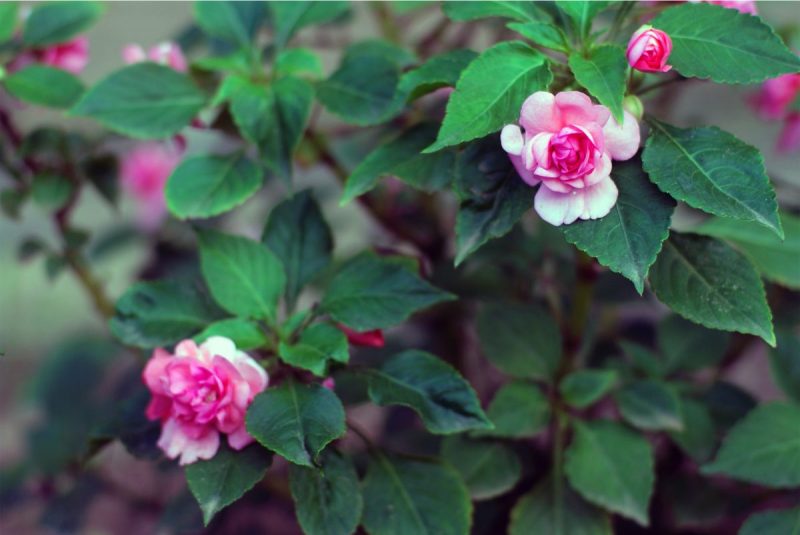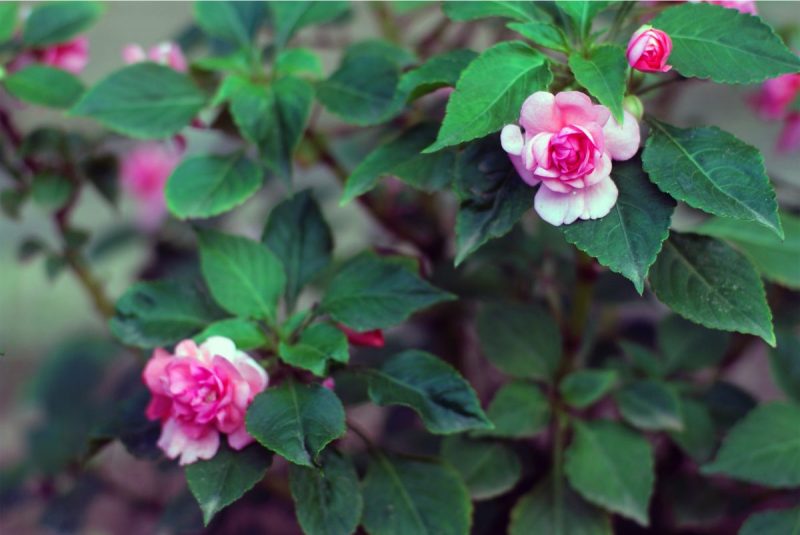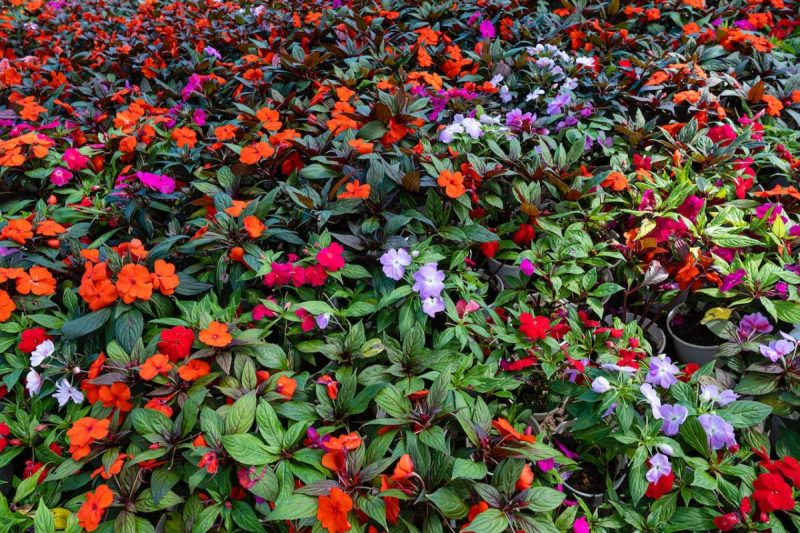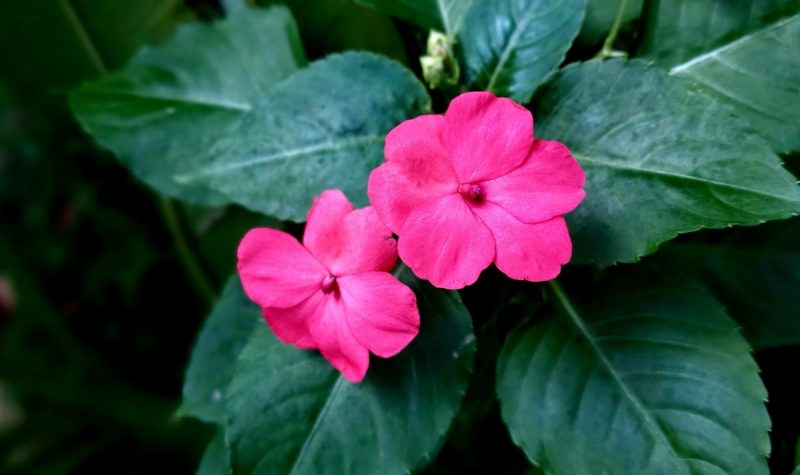Impatiens, planting guide and care work

Impatiens (Impatiens spp.) is a perennial species, originally from Africa, New Guinea, which is part of the Balsaminaceae family. Although it is normally a perennial species in tropical areas, Impatiens is often cultivated as an annual plant, its special ornamental characteristics (the variously colored flowers – white, red, pink, purple, violet, yellow) being highly appreciated and used in various landscaping projects (decoration of parks, gardens, terraces, curbs, etc.). It can be grown both as a plant in the garden and in flowerpots/containers, and it can be sheltered indoors during the cold season.
Varieties
- Impatiens balsamina – dwarf variety with large, brightly colored flowers;
- Impatiens walleriana – it bears orange and purple flowers;
- Impatiens hawkeri– variety with pink and orange flowers, with petals outlined in red.



Recommended products
-
You can find products on a different store
Change Store -
You can find products on a different store
Change Store -
You can find products on a different store
Change Store -
You can find products on a different store
Change Store -
You can find products on a different store
Change Store -
You can find products on a different store
Change Store -
You can find products on a different store
Change Store -
You can find products on a different store
Change Store -
You can find products on a different store
Change Store -
You can find products on a different store
Change Store -
You can find products on a different store
Change Store -
You can find products on a different store
Change Store -
You can find products on a different store
Change Store -
You can find products on a different store
Change Store -
You can find products on a different store
Change Store -
You can find products on a different store
Change Store -
You can find products on a different store
Change Store -
You can find products on a different store
Change Store -
You can find products on a different store
Change Store -
You can find products on a different store
Change Store -
You can find products on a different store
Change Store -
You can find products on a different store
Change Store -
You can find products on a different store
Change Store -
You can find products on a different store
Change Store
Environmental conditions
Light. It grows and develops properly in shaded places.
Temperature. It is a species quite sensitive to high temperatures, and thus, the plants can take on a withered appearance during warm, prolonged periods. They regain their normal appearance after watering. For optimal growth and flowering, it needs a temperature of 18–20 °C, and in winter, it must not fall below 13 °C.
Soil. It prefers soils/substrates that ensure a good water drainage, that are fertile, with a slightly acidic pH (6.0 – 6.5). Proper water drainage is essential, as this species needs frequent watering during the vegetative growth period. As a result, waterlogging must be avoided.
Care
Watering. It is recommended that watering be carried out regularly, so that the substrate/soil is kept damp.
Fertilizing. For prolific flowering, it needs a soil/substrate rich in nutrients. Thus, immediately after planting, it is recommended to administer some balanced fertilizers, which have the role of stimulating the rooting. Later, during the vegetative growth period, to ensure their development and to help the flowering process, regular administration of fertilizers specially formulated for flowering plants is recommended.
Recommended products
-
You can find products on a different store
Change Store -
You can find products on a different store
Change Store -
You can find products on a different store
Change Store -
You can find products on a different store
Change Store -
You can find products on a different store
Change Store -
You can find products on a different store
Change Store -
You can find products on a different store
Change Store -
You can find products on a different store
Change Store -
You can find products on a different store
Change Store -
You can find products on a different store
Change Store -
You can find products on a different store
Change Store -
You can find products on a different store
Change Store -
You can find products on a different store
Change Store -
You can find products on a different store
Change Store -
You can find products on a different store
Change Store -
You can find products on a different store
Change Store -
You can find products on a different store
Change Store -
You can find products on a different store
Change Store -
You can find products on a different store
Change Store -
You can find products on a different store
Change Store -
You can find products on a different store
Change Store -
You can find products on a different store
Change Store -
You can find products on a different store
Change Store -
You can find products on a different store
Change Store
Propagation. It can be carried out both by cuttings and by seeds. The seeds will be sown in hotbeds/containers at least 6-10 weeks before planting. The seeds are spread on the surface of the substrate (pre-moistened), then covered, and placed in well-lit places. After sprouting, they will be kept in optimal conditions until they can be planted outside. The planting of seedlings in the garden will be done after the danger of late frosts and hoar has passed.
Propagation by cuttings is an easy method of propagation and can be carried out almost throughout the entire year. For this method of propagation, tip cuttings are used, which are then placed to root in a fresh, well-moistened substrate.
Recommended products
-
You can find products on a different store
Change Store -
You can find products on a different store
Change Store -
You can find products on a different store
Change Store -
You can find products on a different store
Change Store -
You can find products on a different store
Change Store -
You can find products on a different store
Change Store -
You can find products on a different store
Change Store -
You can find products on a different store
Change Store -
You can find products on a different store
Change Store -
You can find products on a different store
Change Store -
You can find products on a different store
Change Store -
You can find products on a different store
Change Store -
You can find products on a different store
Change Store -
You can find products on a different store
Change Store -
You can find products on a different store
Change Store -
You can find products on a different store
Change Store -
You can find products on a different store
Change Store -
You can find products on a different store
Change Store -
You can find products on a different store
Change Store -
You can find products on a different store
Change Store -
You can find products on a different store
Change Store -
You can find products on a different store
Change Store -
You can find products on a different store
Change Store -
You can find products on a different store
Change Store
Pruning. If towards the end of the summer the plants show a strong growth, they can be trimmed, eliminating up to a third of the vegetative part. These cuts are intended to stimulate flowering and to correct the aesthetic appearance of the plant at the same time.
Recommended products
-
You can find products on a different store
Change Store -
You can find products on a different store
Change Store -
You can find products on a different store
Change Store -
You can find products on a different store
Change Store -
You can find products on a different store
Change Store -
You can find products on a different store
Change Store -
You can find products on a different store
Change Store -
You can find products on a different store
Change Store -
You can find products on a different store
Change Store -
You can find products on a different store
Change Store -
You can find products on a different store
Change Store -
You can find products on a different store
Change Store -
You can find products on a different store
Change Store -
You can find products on a different store
Change Store -
You can find products on a different store
Change Store -
You can find products on a different store
Change Store -
You can find products on a different store
Change Store -
You can find products on a different store
Change Store -
You can find products on a different store
Change Store -
You can find products on a different store
Change Store -
You can find products on a different store
Change Store -
You can find products on a different store
Change Store -
You can find products on a different store
Change Store -
You can find products on a different store
Change Store
Dormancy. Considering its tropical origins, Impatiens cannot withstand low temperatures during the cold season, and the plants die at the first light frost. Thus, in the case of plants grown in the garden, it is recommended to remove dry/frost-affected specimens, and plants grown in containers/flowerpots can be moved indoors, in sheltered places, where they can benefit from indirect sunlight, reduced watering and the interruption of fertilization, in order to slow down their growth during the winter.
Diseases and pests
The plant can be affected by various leaf spots, Impatiens downy mildew (Plasmopara obducens), viruses or soil pathogens. Among the pests, the most common are thrips, whiteflies, mites.
Additionally
- The name of the plant comes from the Latin “impatiens” which means impatient. The name is related to the fact that at maturity, the capsule containing the seeds opens at the lightest touch.















































































































































































































































































































































































































































